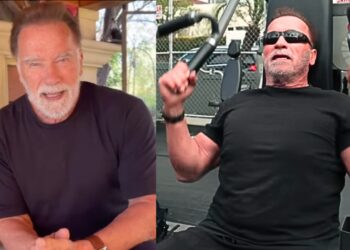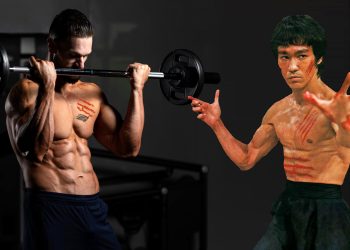Building strong posterior chain muscles is crucial for avoiding injuries and increasing overall performance. Although it is no secret that deadlifts are one of the best posterior chain exercises, if you are like most people, you’re probably wondering which deadlift variation will get you the best bang for your buck.
A study conducted by Plos One, titled “Electromyographic activity in deadlift exercise and its variants,” concluded that the stiff leg deadlift leads to greater erector spinae engagement than the traditional barbell deadlift. (1)
As a Faculty of Sport and Physical Education (Serbia) student, I can vouch for dumbbell stiff leg deadlifts as an incredibly potent exercise for inducing glute and hamstring hypertrophy. Therefore, I created an easy-to-follow dumbbell stiff leg deadlift guide so you get the most out of this exercise.
How To Perform the Dumbbell Stiff Leg Deadlift Guide
Below is a step-by-step dumbbell stiff leg deadlift guide to teach you the proper form and technique to avoid injuries and maximize performance.
Step One — Assume the Starting Position
Pick two dumbbells of appropriate weight. Stand upright with your feet hip or shoulder-width apart, depending on your preference. Fully extend your knees, keep your back flat, eyes locked straight ahead while holding the dumbbells in front of your thighs with a pronated grip.
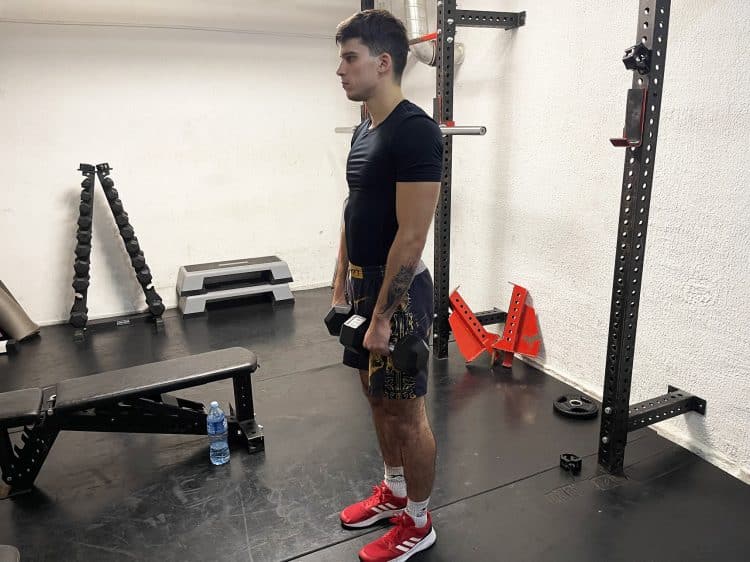
Level Up Your Fitness: Join our 💪 strong community in Fitness Volt Newsletter. Get daily inspiration, expert-backed workouts, nutrition tips, the latest in strength sports, and the support you need to reach your goals. Subscribe for free!
Pro Tip: One of the best stiff-leg deadlift tips I can give you is to maintain a slight lower back arch during the starting position. This is to protect your spine and engage your lower back muscles effectively.
Step Two — Initiate the Eccentric Phase
Lower your torso towards the floor by bending at your hips; avoid flexing your ankles and knees during the exercise. If your mobility allows, touch the dumbbells to the floor. However, refrain from rounding your back to avoid unnecessary lower back strain.
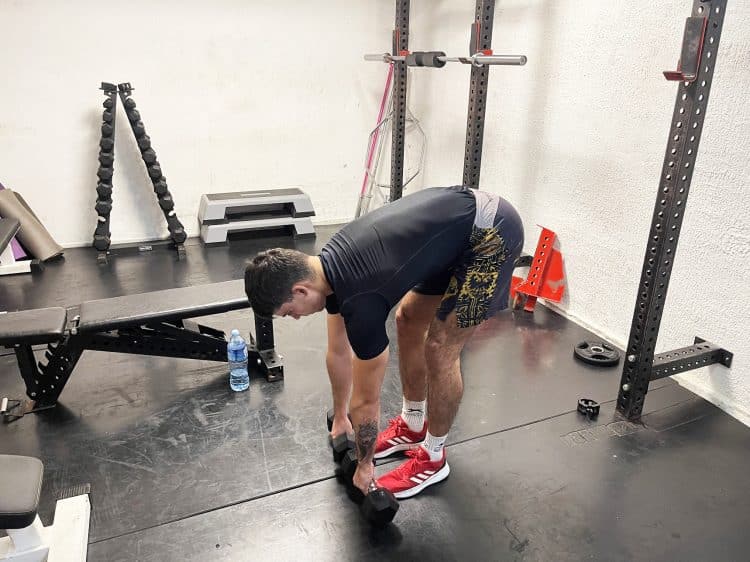
Pro Tip: During the eccentric phase, focus on hinging at your hips and keeping your chest proud while maintaining stiff legs to target your hamstrings.
Step Three — Initiate the Concentric Phase
Reverse the motion by extending your hips to return to the starting position. Again, don’t bend your knees and ankles; keep your back flat and core tight. This is one rep.
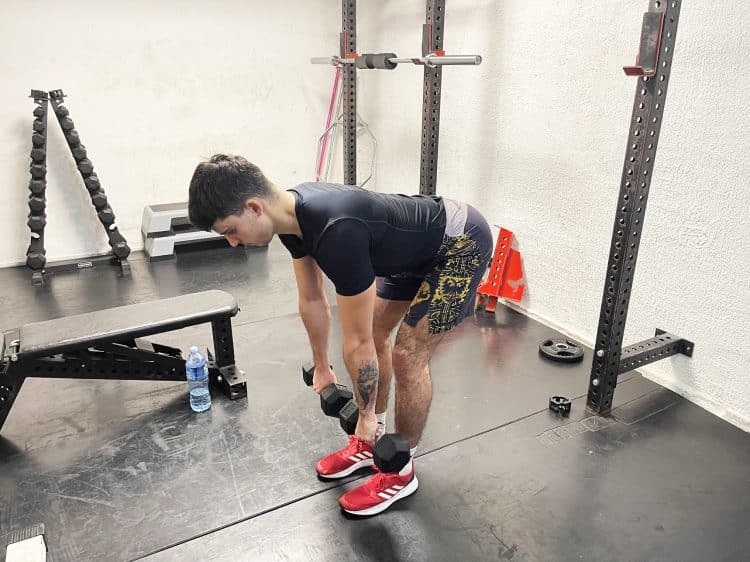
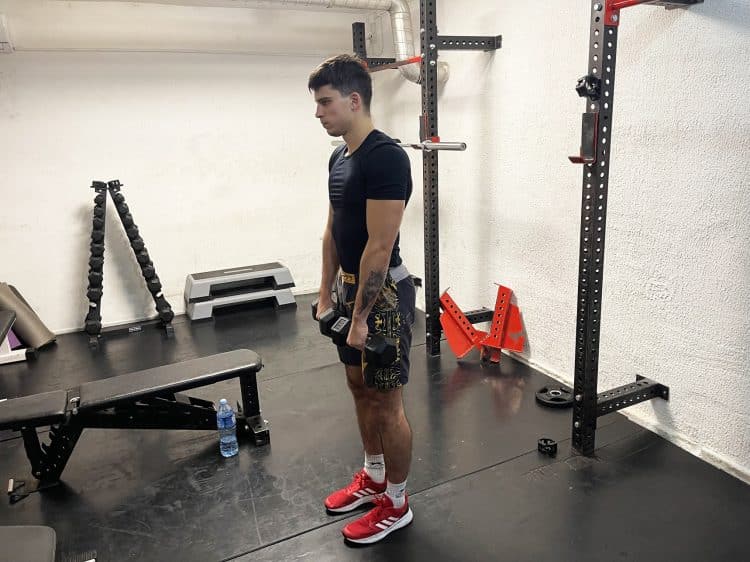
Pro Tip: Squeeze your glutes at the top to fully engage your hip extensors and maximize the lift’s effectiveness.
Muscles Worked in Dumbbell Stiff Leg Deadlifts
The dumbbell stiff leg deadlifts target the hamstrings, glutes, erector spinae, adductors, and calves. Let’s break down each muscle group further:
Hamstrings
The hamstrings consist of three primary muscles: biceps femoris, semitendinosus, and semimembranosus. All three muscles work together during dumbbell stiff leg deadlifts. However, the biceps femoris, particularly its long head, does most of the heavy lifting during hip extension, which is basically the concentric phase of dumbbell stiff leg deadlifts.
Gluteus Maximus
Gluteus maximus is the prime mover during dumbbell stiff leg deadlifts. With the help of the gluteus minimus, maximus, and hamstring muscles, it helps with forceful hip extension. The glutes are responsible for hip extension during stiff leg deadlifts.
Erector Spinae
While many people believe erector spinae is the prime mover during deadlifts, that is not true. The erector spinae almost always serves as a stabilizer muscle during deadlifts, especially because the majority of it is working in the isometric contraction, except for the small part located distally towards the hip.
Adductors
The adductor muscle complex is primarily responsible for balance in the frontal plane. Together with gluteus medius, they generally help stabilize the knee and legs. These muscles include the adductor brevis, adductor longus, adductor magnus, gracilis, and pectineus.
Calves
Calves are a secondary muscle group during the stiff deadlift movement. This is because there is no ankle movement (dorsiflexion or plantarflexion).
Benefits of Dumbbell Stiff Leg Deadlifts
There are many benefits of dumbbell stiff leg deadlifts, some of which are covered below:
Strengthens Hamstrings
Deadlifts, in general, are great for strengthening your posterior chain muscles. Stiff leg deadlifts will build exceptionally strong biceps femoris, semitendinosus, and semimembranosus.
These muscles are crucial for quickly starting and stopping while running, which is especially important in team sports such as handball, football, and basketball.
Enhances Lower Back Stability
Lower back strength is crucial for your overall posture and preventing certain injuries. Dumbbell stiff leg deadlifts strengthen your erector spinae while working your quadratus lumborum and other pelvic floor muscles.
Improves Posture
Healthy and strong posterior chain muscles equal better posture. Strong calves, hamstrings, glutes, and back muscles can help improve overall posture.
Develops Glute Muscles
Dumbbell stiff leg deadlifts can help build bigger and stronger glutes. These include gluteus maximus, gluteus medius, and gluteus minimus. This is so important nowadays because more and more people live sedentary lifestyles.
Sitting for prolonged periods forces your glutes to elongate and lose some of their power and strength, which can hamper your posture.
Increases Grip Strength
You need a strong grip to lift heavy. However, there is one thing that I find absolutely mindboggling about grip strength. According to a Dove Press study titled, “the routine use of grip strength can be recommended as a stand-alone measurement for identifying older adults at risk of poor health status.” (2)
The study also states that grip strength can also help assess:
- Overall strength
- Bone mineral density
- Upper limb function
- Fractures
- Malnutrition
- Falls
- Cognitive impairment
- Sleep problems
- Depression
Drawbacks of Dumbbell Stiff Leg Deadlift
Every exercise has its pros and cons. I created the list below based on my personal experience and after consulting other fitness experts in the field.
Risk of Back Strain
If you perform dumbbell stiff leg deadlifts too fast and without proper control of the entire movement, there is a great chance you will strain your back.
This is why I always emphasize in all my articles and guides to perform the eccentric phase deliberately. Obviously, every rule has exceptions, but slow eccentrics will do the trick for most people.
Limited Quadriceps Engagement
Since this exercise involves keeping your knees extended throughout the range of motion, it limits quad engagement.
Advanced Exercise
Deadlifts can be challenging and complex for beginners, and the dumbbell variation adds more difficulty. Specifically, in the dumbbell variation, you must lower yourself to the floor, which demands significant hamstring flexibility to prevent lower back rounding and maintain core integrity.
Requires Dumbbells
This is a drawback if you want to perform stiff leg deadlifts in your home gym but don’t own a pair of dumbbells. Also, dumbbells involve greater core stabilizer activation than barbells.
Level Up Your Fitness: Join our 💪 strong community in Fitness Volt Newsletter. Get daily inspiration, expert-backed workouts, nutrition tips, the latest in strength sports, and the support you need to reach your goals. Subscribe for free!
Potential for Overuse
I often see people overdo the single-leg deadlifts and Romanian deadlifts, increasing their risk of chronic fatigue and injuries.
Best Dumbbell Stiff Leg Deadlift Variations and Alternatives
Add the following dumbbell stiff leg variations and alternatives to your exercise arsenal:
Dumbbell Romanian Deadlift
When I started my weightlifting journey, I confused Romanian deadlifts with stiff-leg deadlifts as they looked similar. However, after learning the difference, I find the stiff leg deadlifts more challenging than the RDLs as they require greater posterior chain mobility. Now, I consider a Romanian deadlift a regression exercise to the dumbbell stiff leg deadlift.
Steps:
- Pick two dumbbells of appropriate weight.
- Assume a hip-width apart stance, bend your knees slightly, and keep them fixed in this position throughout the entire exercise.
- Maintain a flat back and keep your gaze forward as the dumbbells hang near your hips.
- Start the exercise by bending at your hips and lowering the dumbbells towards the floor.
- Pause for one second when the dumbbells reach knee level.
- Return to the starting standing position by reversing the motion.
- Repeat for the desired number of reps.
Pro Tip: This is the exercise I suggest to enhance the mind-muscle connection and target your hamstrings and glutes effectively. Focus on pushing your hips back as you lower the dumbbells, ensuring your knees remain slightly bent.
Dumbbell Single-Leg Romanian Deadlift
The dumbbell single-leg Romanian deadlift is one of my personal favorite unilateral exercises for strengthening the posterior chain. I believe everyone should strive to implement this exercise into their lifting routine because it is highly functional and will build enormous amounts of stability in your knees and especially hips.
Steps:
- Pick one dumbbell of appropriate weight and assume a hip-width stance.
- While holding the dumbbell in your right hand, slightly bend your left knee and lift the right foot off the floor.
- Keep your back flat and head neutral.
- Begin by lowering your torso toward the floor by hinging at your hips.
- Simultaneously, lower the dumbbell towards the floor and lift the right leg backward and up.
- Hold that position for one second when the dumbbell is below your knees.
- Reverse the motion by extending your hips.
- Repeat for the desired amount of reps.
Pro Tip: When performing single-leg Romanian deadlifts, maintain a stable core and engage your glutes throughout the entire motion. This will improve balance and strengthen your hip stabilizers.
Kettlebell Stiff Leg Deadlift
The kettlebell stiff-leg deadlift is the same as the dumbbell stiff-leg deadlift. It is just performed with kettlebells instead of dumbbells.
Steps:
- Pick two kettlebells of appropriate weight and get into the starting deadlift position.
- Start the exercise by bending at your hips (hip hinge movement) and lowering both kettlebells towards the floor.
- Hold the bottom position for one second when both kettlebells are below your knees.
- Reverse the motion by extending your hips.
- Repeat for the desired number of reps.
Pro Tip: Use a tight grip on the kettlebells for optimal balance and stability. It will also maximize your posterior chain engagement.
Trap Bar Deadlift
If I were to choose just one strength training exercise to do for the rest of my life, it would be the trap bar deadlift.
This exercise combines squats and deadlifts, shifting your center of mass right where it needs to be to activate both posterior and anterior chain muscles. Trap bar deadlifts will build your glutes, hamstrings, quads, and erector spinae. Also, they will improve your overall athletic performance and increase lower body muscle mass.
Steps:
- Load the trap bar with the appropriate weight.
- Step into the trap bar and take a neutral grip with both hands.
- Assume a hip-width stance.
- Bend at your ankles, knees, and hips to enter the starting position while keeping your back and head neutral (follow this cue for all deadlift variations).
- Extend your ankles, knees, and hips to drive the trap bar toward the ceiling.
- Stand tall and hold that position for one second.
- Reverse the motion and slowly lower the trap bar to the floor.
- Repeat for the desired number of reps.
Pro Tip: To prevent lower back strain and improve lift efficiency, maintain a neutral spine and engage your lats. You can do this by thinking about “bending the bar” as you lift, which helps stabilize your upper body.
Glute Bridge
Bodyweight glute bridges are a perfect regression exercise if you struggle with more complex deadlift variations, such as the stiff leg and Romanian deadlifts.
However, you can perform the glute bridges by placing a barbell or dumbbell on your hips or wrapping resistance bands around your knees.
Steps:
- Lay down on the floor on your back.
- Place your hands beside your body for added support, and bend your legs to bring the heels closer to your butt.
- From this position, extend your hips forcefully toward the ceiling.
- Hold the top position for one second and squeeze your glutes.
- Lower the hips down slowly and repeat for the desired number of reps.
Pro Tip: Maintain a straight line from your shoulders to your knees at the top of the bridge to ensure proper glute activation.
FAQs
How much weight should I use for a stiff leg deadlift?
You should use your current fitness goal as a benchmark for determining the right weight to use for stiff leg deadlifts. For endurance, pick a weight you can lift for 12 to 25 reps for multiple sets.
When aiming for hypertrophy, perform three sets of six to 12 reps with 60-80% of your one-rep max (1RM); limit rest duration to 30 to 90 seconds to maximize muscle stimulation. To build strength, opt for weights exceeding 80% of your 1RM, perform one to six reps per set, rest for two to five minutes between sets, and aim for at least four sets.
Is a dumbbell stiff leg deadlift better than RDL?
As with every other exercise comparison, this entirely depends on your goal and morphology. Dumbbell stiff leg deadlifts involve keeping the knees extended, whereas RDLs involve slight knee flexion.
More importantly, stiff leg deadlifts involve touching the dumbbells to the floor with each rep, whereas you don’t go all the way down on RDLs to keep constant tension on the posterior chain. This means that dumbbell stiff leg deadlifts require better mobility.
Should I feel a stretch in my hamstrings during the entire range of motion?
Yes, you should feel tension in your hamstrings during the whole range of motion when performing dumbbell stiff leg deadlifts. This is because the exercise’s primary goal is to target your posterior chain muscles by requiring them to lengthen and shorten.
Balancing stretching and maintaining proper form and technique is essential when performing stiff leg deadlifts. Beginners often risk injury by lowering the dumbbells too quickly or losing control, so always prioritize correct form and technique.
Can dumbbell stiff leg deadlifts help improve my posture over time?
Yes, dumbbell stiff leg deadlifts can help improve your posture over time. The posterior chain and core muscles play the most significant role in strengthening your lumbar spine and preventing excessive lordosis.
Strengthening your posterior chain muscles, including the glutes and hamstrings, gradually improves your posture. This is also important for preventing or minimizing the risk of back injuries while training.
What are some common mistakes to avoid when performing dumbbell stiff leg deadlifts to prevent injury?
Avoid rounding your back while performing the dumbbell stiff leg deadlift. Keep your back neutral and maintain the natural curvature of the spine. Keeping your back entirely flat during this exercise is impossible, and many fitness so-called “experts” get this wrong.
When I say “flat,” I mean maintaining your spine’s natural curves, known as kyphosis and lordosis. Also, you should avoid going too deep with the dumbbells if your hamstring muscles are not flexible enough. This can lead to excessive strain on the other parts of your body, which usually results in injury.
Are there any specific breathing techniques I should follow during the exercise to maximize its benefits?
I tried many specific breathing techniques over the years, and the following works the best, at least for me, while performing stiff leg deadlifts.
Brace your core, exhale during the concentric phase, and inhale during eccentrics. This also boosts your overall focus and confidence.
Lastly, please avoid holding your breath. I say this because breath-holding will likely lead to a sudden increase in intra-abdominal pressure, which is extremely dangerous.
Wrapping Up
Dumbbell stiff leg deadlifts are an excellent exercise for bulletproofing your posterior chain muscles, which reduces the chance of injury and improves your posture and lower back stability. I believe that this is crucial for your longevity, especially if you are an athlete who constantly runs, changes direction, and requires more agility and the ability to stop quickly.
When you decide to implement this exercise into your routine, you also must think about other muscles that are not entirely working, such as all quad muscles. This is why I generally recommend performing conventional barbell back squats and deadlifts along with stiff leg deadlifts.
References
- Martín-Fuentes I, Oliva-Lozano JM, Muyor JM. Electromyographic activity in deadlift exercise and its variants. A systematic review. PLoS One. 2020;15(2):e0229507. Published 2020 Feb 27. doi:10.1371/journal.pone.0229507
- Bohannon RW. Grip Strength: An Indispensable Biomarker For Older Adults. Clin Interv Aging. 2019;14:1681-1691. Published 2019 Oct 1. doi:10.2147/CIA.S194543
Interested in measuring your progress? Check out our strength standards for Stiff Leg Deadlift, Dumbbell Romanian Deadlift, Deadlift, and more.






